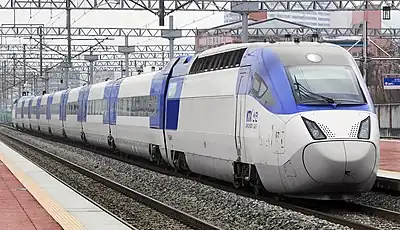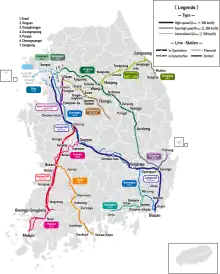Rail travel in South Korea
South Korean high-speed rail system
South Korea is home to a modern and efficient national railway network connecting all the major mainland cities operated by the state-owned Korail. For most travellers, these are the most convenient way to get around mainland South Korea. It goes without saying, however, that you cannot take the train into North Korea.


High-speed rail
South Korea's high speed service is known as Korea Train Express, abbreviated KTX. It is operated by national train operator, Korail.
Since 2016, the competing Super Rapid Train (SRT) also offers services on the core Seoul-Busan/Mokpo routes.
Train types
KTX
Most KTX trains leave from Seoul Station or Yongsan Station and terminate in the cities of Busan, Gwangju, Mokpo, Yeosu, Pohang, Gangneung and Jinju. Most major cities are served in between.
The KTX train is regarded as an easier, more comfortable and cheaper way to get around South Korea than by plane. If you figure in security and getting to/from the airport it may also just be faster to go by train. Ticket prices are slightly below the equivalent airfare of the major airlines. The weekday Standard class price for Seoul-Busan is around ₩57,000.
There are two types of KTX seat; first class and standard class. First class is 50% more expensive but you get wider seats, free bottled water and snacks.
There are three types of KTX trains, KTX-I, KTX-Sancheon, and KTX-Eum. KTX-Sancheon has better seats with individual power plugs. KTX-I trains have fewer power plugs between the window. There is no extra fare for KTX-Sancheon. KTX-Eum is the latest train, and runs only on the Jungang line to Wonju, Jecheon, Yeongju, and Andong.
SRT
SR operates their high-speed SRT services from Suseo station in southeastern Seoul. It serves the same route as the Gyeongbu and Honam KTX after Cheonan-asan. It uses separate booking system and app, but has same KTX-Sancheon train and its offline tickets can be bought from the Korail counters, just like the regular KTX. It is around 10% cheaper and can be more convenient if you're travelling to the Gangnam district or elsewhere in eastern Seoul. Most of the services by Korail such as the Korail pass will not be applied. SRT has a slightly sparser schedule than Korail with fewer departures.
Lines in service
All lines start in Seoul and terminate in either the southwest or southeast of the country. Seoul has three main KTX stations (Seoul, Yongsan, Cheongnyangni); Seoul station for mainly Gyeongbu, Gyeongjeon lines, and Yongsan station for Honam and Jeolla lines, and Cheongnyangni for Gangneung line. Also, Suseo station at the southeast of the Seoul serves SRT.
Keep in mind that few KTX trains use conventional line to serve stations at Suwon, Gupo (West of Busan), Nonsan, etc. These trains are slower, but cheaper.
These are the major stops.
- Gyeongbu KTX :Seoul (Seoul) - Cheonan-asan - Daejeon - Daegu (Dongdaegu) - Busan or Pohang
- Honam KTX : Seoul (Yongsan) - Cheonan-asan - Gongju - Iksan - Gwangju (GwangjuSongjeong) - Mokpo
- Gyeongjeon KTX : Seoul (Seoul) - Cheonan-asan - Daejeon - Daegu (Dongdaegu) - Miryang - Changwon - Jinju
- Jeolla KTX : Seoul (Yongsan) - Cheonan-asan - Gongju - Iksan - Jeonju - Suncheon - Yeosu
- Gangneung KTX : Seoul (Mainly Cheongnyangni, Some departs from Seoul) - Wonju (Manjong) - Pyeongchang - Gangneung or Donghae.
- Jungang KTX : Seoul (Cheongnyangni) - Wonju (Wonju) - Jecheon - Yeongju - Andong
- SRT : Seoul (Suseo) - Dongtan - Pyeongtaek(PyeongtaekJije) - continues with the same Gyeongbu/Honam KTX line after Cheonan-asan
Some KTX trains proceed north from Seoul to Haengshin.
Riding KTX from and to Incheon International Airport
There were KTX services from Incheon International Airport in the past, but was discontinued after 2018 Olympics. If you're going to use KTX (except those using Gangneung or Jungang KTX) from the airport, take the 6770 bus to get to the Gwangmeyong Station and continue on the KTX. It's faster and cheaper than going all the way to Seoul and riding the KTX.
Also, when you're going to Incheon Airport, you can use City-Airport Terminal at Gwangmyeong station. You can go through check-in and immigration if you're using selected airlines.
Future lines
A plan to build an undersea tunnel to Jeju has been mooted by the government. The Seoul-to-Jeju airline route is the busiest in the world, although construction would involve building the longest tunnel in the world and it is not clear if Korea would be prepared to invest the huge amount needed.
Booking tickets
Tickets may be purchased up to one month in advance at any Korean Rail station ticket office, or online at Korail's website. The online option has the benefit of allowing you to book in English, and tickets can be picked up in advance from any Korean Rail Ticket Office. However, you must bring your passport for identification when picking up the tickets. There is also a clunky but usable iPhone app which supports English. Foreign credit cards can be used to book tickets which then can be accessed through the app.
Standby (입석, ipseok) tickets cannot be purchased online; those can only be purchased at ticket machines at the major stations.
SRT trains can be booked on their website.
During Lunar New Year (late Jan or Feb) and Chuseok (Sep or early Oct) dates, it is practically impossible to travel by train during these periods due to all the crowds.
Conventional trains
Non-high-speed trains are divided into the following classes:
- ITX'-Cheongchun (ITX-청춘) — The fastest non-high-speed trains, travelling at up to 180 km/h in an all-seater configuration, running between Seoul's Yongsan Station and Chuncheon.
- ITX-Saemaeul (ITX-새마을) — Modern all-seater trains travelling up to 150 km/h.
- Nuriro (누리로) — Semi-express trains running on some shorter routes.
- Saemaeul-ho (새마을호) — Older all-seater express trains that stop at fewer stations than Mugunghwa-ho. Has mostly been superseded by the ITX-Saemaeul, and now only operates on the Seoul-Iksan route.
- Mugunghwa-ho (무궁화호) — The slowest and most basic train service, stopping at most stations and featuring standing room.